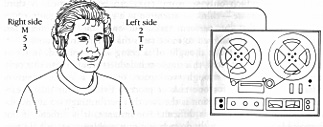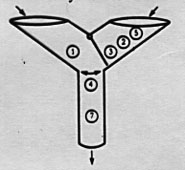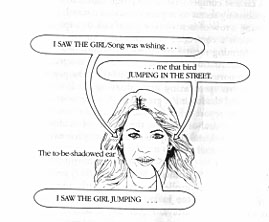Week 2 Attention and Automaticity
What is Attention
- Attention refers to the concentration and focusing of mental effort
- Selective
- Shiftable
- Divisable.
Studies of Dichotic Listening
- Dichotic listening tasks involve asking subjects to listen to different information in each ear.

- Shadowing: Messages are presented to both ears but subject is told to attend to only one of the messages and repeat it out loud.
- By and large subjects find it easy to perform this task
- Subjects can remember what was said on the attended channel.
- Some things subjects DON'T know about the unattended channel
- What words were spoken.
- The topic being discussed.
- The language of the voice.
- Some things subjects DO know about the unattended channel
- Whether it was a human voice or just noise
- Whether it was a male or female voice.

Models of Attention
- The Bottleneck Model (Broadbent, 1958)
- The basic claims of the model
- Sensory channels have an unlimited capacity
- There is a bottleneck allowing only one piece of information into working memory at a time.
- A selective filter allows in information from only one channel at a time.
- Information from unattended channel is completely blocked
- Time is required to switch from one channel to the next

- Evidence for the Bottleneck Model
- Explains the results of the shadowing experiments above. The reason that people can't repeat the message from the unattended ear according to Broadbent is
because the message is being completely blocked.
- Broadbent (1958): Subject in dichotic listening task are presented with digits simultaneously to each ear. They are asked to report all of the numbers.
- Subjects tended to report all the information coming to one ear first then all the information coming to the other ear.
- If subjects are required to report digits in the order of arrival they did better the more time there is between presentations.
- Evidence Against the Bottleneck Model
- The cocktail party effect
- Errors in shadowing (Treisman, 1960)

- Galvanic Skin Response studies.
- Galvanic skin response is a measure of the electrical conductance of the skin and can be used to indicate increased emotional arousal.
- Subjects in the training phase of one experiment were given a mild electric shock every time a certain word was presented.
Dog
Hat
Beer
Couch ("Ow!")
Rabbit
Money
Cup
Couch ("Ow!")
Pine
.....
- This training is of course an example of Classical Conditioning. After training,
hearing the word "Couch", even without the electric shock, produced a mild fear response which could be measured by means of the Galvanic Skin thingamajig.
- Later on in a shadowing task the word "Couch" was presented to the non-shadowed ear.
- Subjects showed an emotional response to the word even though they were not consciously aware of hearing it.
Treisman's Attenuation Model
- The Basic Claims of the Attenuation Model
- Messages differ in terms of their "subjective loudness". Paying attention to a message means increasing its subjective loudness.
- In the shadowing task, messages from the shadowed ear have a higher subjective loudness than messages from the non-shadowed ear.
- There is also a dictionary which contains words and concepts. Concepts in the dictionary differ in terms of the subjective loudness required for that concept to be noticed.
- Some concepts are permanantly in the dictionary at a low threshold (like one's name) and some concepts are temporarily in the dictionary at a low threshold due to one's current goals.
- Evidence supporting the attenuation model
- It explains the cocktail party effect. Your name has a permanently low recognition threshold. So it will be recognized even if it is presented to the non-shadowed ear.
- It explains contextual errors in shadowing. Concepts related to the message in the shadowed ear temporarily have their recognition threshold lowered. Thus when those concepts are mentioned in the non-shadowed ear they are recognized in spite of their low subjective loudness.
- It explains the Galvanic Skin experiments because unattended messages aren't completely blocked they are just attenuated so that the subject is not consciously aware of them.
Late Selection Models (Norman, 1968)
- The previous two models assumed that attention served to determine the nature of the information that got into Short Term Memory. These two models are called Early Selection Models because they assume that attentional selection occurs early, before information enters Short Term Memory.
- Late Selection Models assume that all information gets into Short Term Memory but that information which isn't attended to is rapidly forgotten (within a fraction of a second). They are called Late Selection Models because the selection doesn't occur until fairly late in the process, when information is already in Short Term Memory.
- Late Selection Models and Early Selection Models make drastically different assumptions about the nature of Short Term Memory.
- The models we've been talking about so far (Early Selection Models) treat Short Term Memory as a small box into which only a few (7 +/- 2) items can fit. Attention picks items to go into that small box.
- Late selection models treat Short Term Memory as large box into which many items can fit but in which items disappear quite rapidly unless they are attended to.
- Imagine a plate spinner who is performing in a very large auditorium. Since the auditorium is large it can contain very many spinning plates. But the plate spinner can only move so fast. He can only keep a small number of the plates spinning. The rest will crash to the floor. The smart plate spinner will focus on keeping the most valuable plates spinning and will let the rest fall and break.
- Late selection models say that Short Term Memory is alot like that room with all the spinning plates. It can contain many items but those items disappear quite quickly unless attention keeps them spinning (activated). And attention can only keep around 7 items spinning (or activated) at a time.
Automatic versus Strategic Processing
- Definitions
- Automatic Process: A skill which can be performed reliably with minimal attention.
- Occur without intention.
- Doesn't give rise to conscious awareness of the PROCESS being used to perform the skill
- Doesn't interfere with other activities.
- Strategic Process: A skill which can only be performed reliably with attention.
- Skills which are initially strategic can become automatic.
- Pluses and Minuses of automatic processing
- Pluses of automaticity
- Allows people to perform multiple tasks at a time.
- Allows people to build complex skills.
- Minuses of automaticity
- Sometimes people can make careless mistakes.
- Sometimes people can miss details:
FINISHED FILES ARE THE RESULT OF YEARS OF SCIENTIFIC STUDY COMBINED
WITH THE EXPERIENCE OF MANY YEARS.(Healy, 1980)
- Instance Theory of automatization (Logan, 1988).
- For certain tasks at least you can think of automatization as arising from a race between memory and a procedure.
- Consider addition:
"What is 12 + 5?"
- If you've solved this problem before you can get this information from memory.
- Or you can work out a solution the long way.
- Logan assumes that each time you solve the problem you get a new instance of the problem stored in memory. Its like finding a needle in a haystack. If there's only one needle its hard to find. But if there are 100 needles its much easier to find.
- Logan's model is self-terminating and parallel. This means that you are both trying to work out the solution the long way and retrieve it from memory at the same time. As soon as you determine a solution (whichever way you do it) you stop working on the problem.
- Skills become increasingly automatic as more and more instances are added to memory and it becomes increasingly likely that the problem will be solved by memory.
- Another corny analogy
- Let's say farmer Logan's daughter Betty Sue is about to get hitched. Right before the wedding Farmer Logan bends over and rips his good Sunday pants. He needs to get them sewn as soon as possible but he doesn't have a needle. He asks his sons John and Phil to help.
- John, whose an expert metal worker, goes about crafting a needle out of raw materials which normally takes him 10 minutes. Phil, remembers that there was a needle dropped in the haystack a while back and starts looking for it. Whoever obtains the first needle, whether it be John by crafting one, or Phil by finding one, will have solved their dad's problem since he only needs one needle.
- If there's only one needle in the haystack, it is likely that John will be able to make one faster than Phil can find one. But when there are many needles in the haystack things change. The more needles there are in that haystack the faster Phil will find a needle and the more likely it will be that Phil will find a needle before John can make one.
- In the same way, Logan's model says that when solving a problem we both try to craft a solution(like John was trying to craft a needle) and at the same time look for an old solution in memory(like Bill was trying to find a needle). And then we stop as soon as either method provides a solution. The more old solutions there are in memory, the more needles there are in the haystack, the more likely we are to solve the problem through memory and the faster we should be able to solve the problem. Given enough needles (instances) in the haystack (memory) solving the problem seems to happen automatically.
Return to
Lecture Notes
Return to Class homepage



